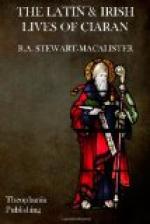It is possible that the prominence of the mother in the household, and Ciaran’s birth away from his ancestral home as the result of a taxation, are specially emphasised because they offer obvious parallels with the Gospel story. The character of Darerca is, however, by no means idealised, as we might have expected it to be, had this been the chief purpose of the narrator.
The Parents of Ciaran, their Names and Origins.—The name of Ciaran’s father is variously Latinised in the Latin Lives. The Irish lives call him Beoit, a name analysed in the Book of Leinster, p. 349, into Beo-n-Aed, which would mean something like “Living Fire.” The _-n-_ is inserted, according to a law of Old Irish accidence, because aed, “fire,” is a neuter word. Thus arises the Latin form Beonnadus. By metathesis the name further becomes transformed to Beodan or Beoan. The Latharna were the people who dwelt around the site of the modern town of Larne, which preserves their name; Mag Molt ("the plain of wethers”) is probably the plain surrounding the town. The Aradenses, to whom LB ascribes the origin of Beoit, were the people known in Irish record as Dal n-Araide, the pre-Celtic people of the region now called Antrim.
Dar-erca, “daughter of brightness” or “of the sky,” was a common female name in ancient Ireland. The Glasraige to whom she belonged was a tribe with divisions scattered in various parts of Ireland. Irluachra was south-east Kerry with adjoining parts of Cork and Limerick. Of her poet grandfather Glas nothing is known.
It would perhaps be too far-fetched to see a hint at a mythological element in the traditions of Ciaran in the signification of his parents’ names. Indeed, considering the Tendenz of the Ciaran Lives, it is remarkable that there is no supernormal element in the account of the birth of this particular saint; supernatural births are almost a commonplace in Irish saints’ lives as a rule.
The saint’s own name is regularly spelt with an initial K or Q in the Latin texts, doubtless because Latin c was pronounced as s before e and i in mediaeval Ireland.




